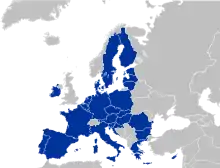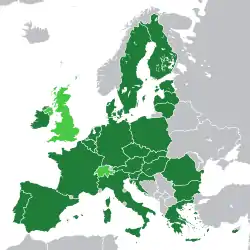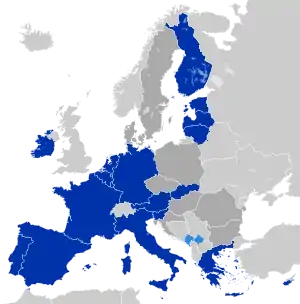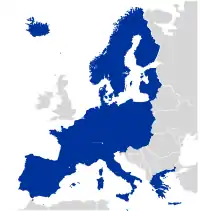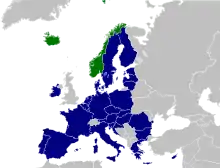Foreign Affairs Council
The Foreign Affairs Council (FAC) is a configuration of the Council of the European Union that convenes once a month. Meetings bring together the Foreign Ministers of the member states. Ministers responsible for European Affairs, Defence, Development or Trade also participate depending on the items on agenda. The configuration is unique in that is chaired by the High Representative of the Union for Foreign Affairs and Security Policy (HR/VP) rather than the Presidency of the Council of the European Union, there is one exception, when FAC meets in the configuration of ministers responsible for trade (FAC/Trade), presiding country's minister chairs the meeting.
 |
|---|
| This article is part of a series on the politics and government of the European Union |
|
|
At its sessions, the Council deals with the whole of the EU's external action, including Common Foreign and Security Policy, Common Security and Defence Policy, foreign trade and development cooperation. A priority in recent years for the Council, in cooperation with the European Commission, has been to ensure coherence in the EU's external action across the range of instruments at the EU's disposal.
Composition
The Foreign Affairs Council gathers different representatives at ministerial level depending on the agenda of a certain Council meeting. Normally the foreign ministers of each country, or their representatives (such as permanent representatives, state secretaries etc.), participate. However, in other cases, defence ministers, trade ministers or development ministers participate.[1][2][3][4]
History
The FAC was created in 2009 by the Treaty of Lisbon by splitting it from the "General Affairs and External Relations Council" with the other part becoming the General Affairs Council. The General and Foreign Councils are the only two Councils mentioned in the EU treaties.
Security role
The EU command and control (C2) structure, as directed by political bodies which are composed of member states's representatives and generally require unanimous decisions, as of April 2019:[5]
- Liaison: Advice and recommendations Support and monitoring Preparatory work
| Political strategic level: | |||||||||||||||||||||||||||||||||
| ISS | EUCO Pres. (EUCO) | Chain of command | |||||||||||||||||||||||||||||||
| Coordination/support | |||||||||||||||||||||||||||||||||
| SatCen | CIVCOM | HR/VP (FAC) | |||||||||||||||||||||||||||||||
| INTCEN | HR/VP (PMG) | HR/VP (PSC) (******) | CEUMC (EUMC) | ||||||||||||||||||||||||||||||
| CMPD | DGEUMS (***) (EUMS) | ||||||||||||||||||||||||||||||||
| Military/civilian strategic level: | |||||||||||||||||||||||||||||||||
Dir MPCC (***) (MPCC) | JSCC | Civ OpCdr CPCC(*) | |||||||||||||||||||||||||||||||
| Operational level: | |||||||||||||||||||||||||||||||||
| MFCdr (****) (MFHQ) | HoM (*) | ||||||||||||||||||||||||||||||||
| Tactical level: | |||||||||||||||||||||||||||||||||
| CC(**) Land | CC(**) Air | CC(**) Mar | Other CCs(**) | ||||||||||||||||||||||||||||||
| Forces | Forces | Forces | Forces | ||||||||||||||||||||||||||||||
- *In the event of a CSDP Civilian Mission also being in the field, the relation with the Civilian Planning and Conduct Capability (CPCC) and its Civilian Operation Commander (Civ OpCdr), as well as the subordinate Head of Mission (HoM), are coordinated as shown.
- **Other Component Commanders (CCs) and service branches which may be established
- ***The MPCC is part of the EUMS and Dir MPCC is double-hatted as DGEUMS. Unless the MPCC is used as Operation Headquarters (OHQ), either a national OHQ offered by member states or the NATO Command Structure (NCS) would serve this purpose. In the latter instance, Deputy Supreme Allied Commander Europe (DSACEUR), rather than Dir MPCC, would serve as Operation Commander (OpCdr).
- ****Unless the MPCC is used as Operation Headquarters (OHQ), the MFCdr would be known as a Force Commander (FCdr), and direct a Force Headquarters (FHQ) rather than a MFHQ. Whereas the MFHQ would act both on the operational and tactical level, the FHQ would act purely on the operational level.
- *****The political strategic level is not part of the C2 structure per se, but represents the political bodies, with associated support facilities, that determine the missions' general direction. The Council determines the role of the High Representative (HR/VP), who serves as Vice-President of the European Commission, attends European Council meetings, chairs the Foreign Affairs Council (FAC) and may chair the Political and Security Committee (PSC) in times of crisis. The HR/VP proposes and implements CSDP decisions.
- ******Same composition as Committee of Permanent Representatives (COREPER) II, which also prepares for the CSDP-related work of the FAC.
